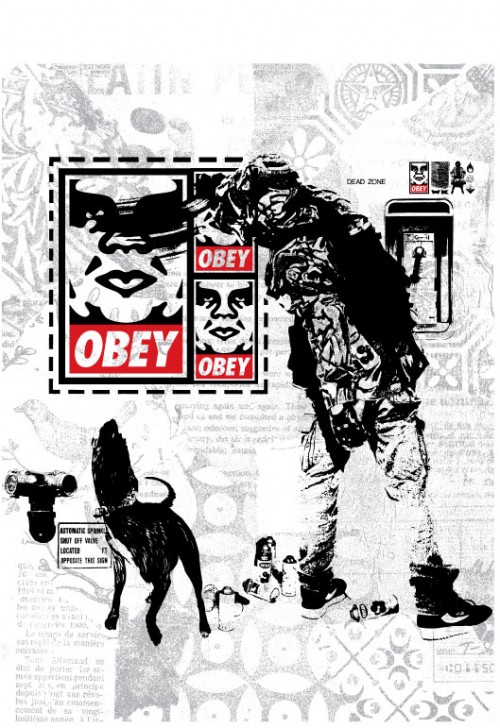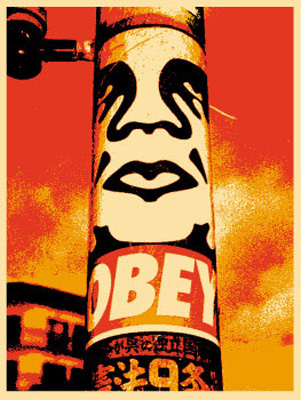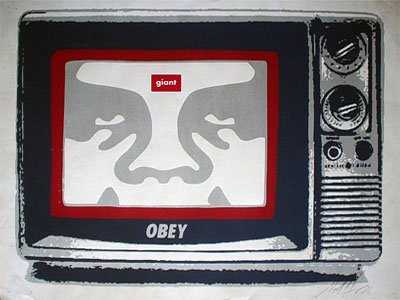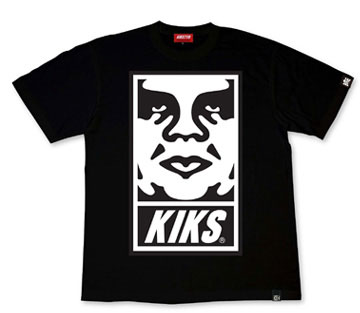 |
|
The Social Lives of Shepard Fairey's Street Art |
 |
| The anthropological approach to interpreting visual objects is made up of three key tenets: materiality, materialization and mobility. As defined in Gillian Rose's book, Visual Methodologies, materiality means to treat images as visual objects that "exist materially in the world" (Rose 219). Contained within this is a concern for the physical (material) qualities of the visual object. Rose defines the second tenet of the anthropological approach, materialization, as the "understanding of how the material qualities of an image intervene in the world, particularly the world of people" (Rose 220). The definition continues with, "An image may have a range of material qualities, but it is only when someone uses the image in some way that any of those qualities become activated, as it were, and significant" (Rose 220). The third tenet of the anthropological approach is mobility, which Rose defines as examining the social lives of images based on how "visual objects travel" (Rose 223). |
 |
It is through these three central characteristics of
the anthropological approach that Shepard Fairey's "Andre the Giant has
a Posse" sticker campaign and its derivative, the OBEY campaign, will be
examined in order to construct their social lives. Important to this
approach will be Lily Shirvanee's conception of "locative media," which
she defines in her work, "Locative Viscosity: Traces of Social History
in Public Spaces," as:
The two aforementioned works by Fairey are both works of street art that have been widely disseminated throughout the world. "Andre the Giant has a Posse" was Fairey's first street art campaign from which the OBEY campaign was derived. (For more on the relationship between the two, see [Home].) Locative media seems to be almost synonymous with the social lives of visual objects and street art, with its geographical location included within its name, seems to be a good option for illustrating the concept....media that actively create and sense a reciprocal awareness between people and their environment, thereby, merging various types of information and media within the limits of specific geographic landscape...Here, locative media is both the mediating technology and the datastreams being exposed and exchanged. (Shirvanee 14) |
| The materiality of a visual object has within it three aspects that make it up: visual form, material form and presentational form. The visual form of a visual object is the image's content, or "what the image shows" (Rose 227). For the "Andre" campaign, the visual form is a picture of a man depicted in black and white with the words, "ANDRE THE GIANT HAS A POSSE," on the left hand side of the image and his height and weight shown on the right side of the image. There is a black border around the image and some indiscernible text near the lower left corner. Due to a copyright claim by the owners of Andre's likeness, Fairey modified his image to the OBEY image. In the OBEY image, there is a man's stylized face depicted in black and white along with the word, "OBEY," written below it in white writing on a red band. There is an outer border of black and an inner border of white that act as frames for the image and text contained within them. |
 |
 |
The material form, or the "physical qualities of the visual object itself," of both images depends on the surface upon which the image is printed and also the surface upon which the image is placed (Rose 227). The earliest forms of "Andre" were stickers that could be placed just about anywhere and some of the most recent OBEY images are wheat pasted onto walls and billboards. In the case of the Fairey's street art, the surfaces that display the image can be considered as part of the visual objects. The presentational form of an image is the "particular way in which an image is presented to the person looking at it" (Rose 227). For "Andre" and OBEY, the presentational form varies, from sticker to poster and any other method of reproduction (of the original image) that Fairey has utilized. Also within a visual object's presentation form is Geoffrey Batchen's idea of an image's "morphological possibilities," or when an image doesn't stay on some form of paper (sticker paper, wheat pasted, poster, etc.). Also, due to both images' iconic status, Fairey has utilized different aspects from them in much of his art. Some of the morphological possibilities that have manifested are his use of the images (or parts of them) in new art pieces and their reprinting onto clothing items and accessories. Of this phenomenon, Michael Dooley, in his work "He Might Be Giant," says, "Once upon a time, [OBEY] was anti-advertising, a silent spokesperson without a product. Now it's become its own brand, with Fairey negotiationing [sic] licensing deals for T-shirts, hats, and backpacks" (Dooley 122). |
|
[Home]
[Foucauldian Discourse Analysis]
[The Social Lives of Images]
|